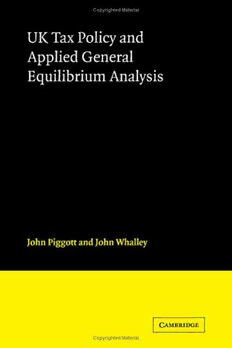
UK Tax Policy and Applied General Equilibrium Analysis PDF
Preview UK Tax Policy and Applied General Equilibrium Analysis
UK tax policy and applied general equilibrium analysis UK tax policy and applied general equilibrium analysis JOHN PIGGOTT Australian National University JOHN WHALLEY University of Western Ontario CAMBRIDGE UNIVERSITY PRESS Cambridge London New York New Rochelle Melbourne Sydney CAMBRIDGE UNIVERSITY PRESS Cambridge, New York, Melbourne, Madrid, Cape Town, Singapore, Sao Paulo, Delhi Cambridge University Press The Edinburgh Building, Cambridge CB2 8RU, UK Published in the United States of America by Cambridge University Press, New York www.cambridge.org Information on this title: www.cambridge.org/9780521104593 © Cambridge University Press 1985 This publication is in copyright. Subject to statutory exception and to the provisions of relevant collective licensing agreements, no reproduction of any part may take place without the written permission of Cambridge University Press. First published 1985 This digitally printed version 2009 A catalogue record for this publication is available from the British Library Library of Congress Cataloguing in Publication data Piggott, John (John R.) UK tax policy and applied general equilibrium analysis. Bibliography: p. 1. Taxation—Great Britain—Mathematical models. 2. Equilibrium(Economics) I. Whalley, John. II. Title. HJ2619.P5 1985 336.2'00724 85-10969 ISBN 978-0-521-30148-0 hardback ISBN 978-0-521-10459-3 paperback To our wives, Dorry and Maggie TABLE OF CONTENTS PREFACE p. Xi ACKNOWLEDGEMENTS p. xiii INTRODUCTION AND SUMMARY OF STUDY PART I: The General Equilibrium Model of the UK - Structure, Data and Model Solution. 16 CHAPTER 1 General Equilibrium Analysis of Tax and Subsidy Policies. p. 17 1.1 General Equilibrium Analysis of Taxes in a Computational Framework. p. 17 1.2 General Equilibrium Analysis of Complete Tax/Subsidy Systems. p. 23 1.3 Equal Tax Yield Comparisons Between General Equilibria. p. 27 1.4 Partition of the Commodities into Goods and Factors in General Equilibrium Models, p. 29 1.5 Computational Solution of General Equi- librium Tax Policy Models. p. 30 CHAPTER 2 The Basic Variant General Equilibrium Model. p. 35 2.1 An Overview of the Basic Variant Model. p- 35 2.2 The Industrial Sector. p. 38 2.3 The Personal Sector. p- 43 2.4 Treatment of Investment Expenditures in the Basic Variant Model. p- 45 2.5 The Public Sector. p- 49 2.6 The External Sector. p« 53 2.7 Equilibrium Solutions for the Model. p- 55 2.8 Dating the Model. p- 57 CHAPTER 3 Model Treatment of UK Taxes, Subsidies and Government Expenditure. p. 64 3.1 An Overview of the 1973 Tax/Subsidy System in the Model. p- 64 3.2 The 1973 UK Tax System. p- 69 3.3 The 1973 UK Subsidy System. p- 81 3.4 The Treatment of Public Sector Expen- ditures, p. 86 3.5 An Initial Overview of the Impact of the 1973 UK Tax/Subsidy System. p. 88 3.6 Developments in UK Taxes and Subsidies between 1973 and 1980. p. 92 CHAPTER 4 Calibrating the model. p. 99 4.1 The Choice of Functional Forms for the Behavioral Equations in the Model. p. 100 4.2 Alternative Approaches to Parameter Selection. p. 101 4.3 The Construction of a Benchmark Equi- librium Data Set. p. 103 4.4 Units Conventions and the Use of the Benchmark Equilibrium Data Set. p. 106 4.5 Consistency Adjustments in the Con- struction of a Benchmark Equilibrium. p. 107 4.6 Determining Parameter Values from the Benchmark Equilibrium Data Set. p. 110 CHAPTER 5 Benchmark Equilibrium Data Set. p.119 5.1 Profit Type Return by Industry. p. 125 5.2 Return to Labour by Industry. p. 129 5.3 Taxes and Subsidies on the Return to Labour and the Profit Type Return. p. 134 5.4 Details of Costs of Production by Industry. p. 135 5.5 Demands for Commodities. p. 135 5.6 Consumer Taxes and Subsidies. p. 140 viii 5.7 Consumer Incomes and Income Taxes. p. 140 5.8 Major Categories of Expenditures by Households. p. 147 5.9 The Public Sector Accounts for the Year 1973. p. 147 5.10 Sources of Income by Sector and Treat- ment of Financial Transactions. p. 152 CHAPTER 6 Specifying Values for Substitution Elasticities. p« 156 6.1 Production Function Elasticities. p. 156 6.2 Demand Function Elasticities. p- 159 6.3 Trade Elasticities. p. 169 6.4 Elasticity Values and the Labour/Leisure Choice. p« 174 6.5 Elasticities and Savings Decisions. p. 176 6.6 Elasticities in the Public Good Model Variant. p. 178 PART II; Empirical Analysis of the UK Tax/Subsidy System Using the General Equilibrium brium Model. p. 181 CHAPTER 7 Detailed Analysis of Central Case Model Experiment Involving Removal of Non- Savings/Non-Leisure Tax/Subsidy Distortion. P. 184 7.1 Introduction. P. 184 7.2 Aggregate Welfare Analysis of the Central Case. p. 185 7.3 Detailed Impacts on Household Groups for the Central Case Analysis. p. 194 7.4 Price and Quantity Adjustments Assoc- iated with the Central Case. p- 205 7.5 Additional Analyses in the Central Case. p. 221 7.6 Summary of Main Findings in Chapter 7. p. 227
